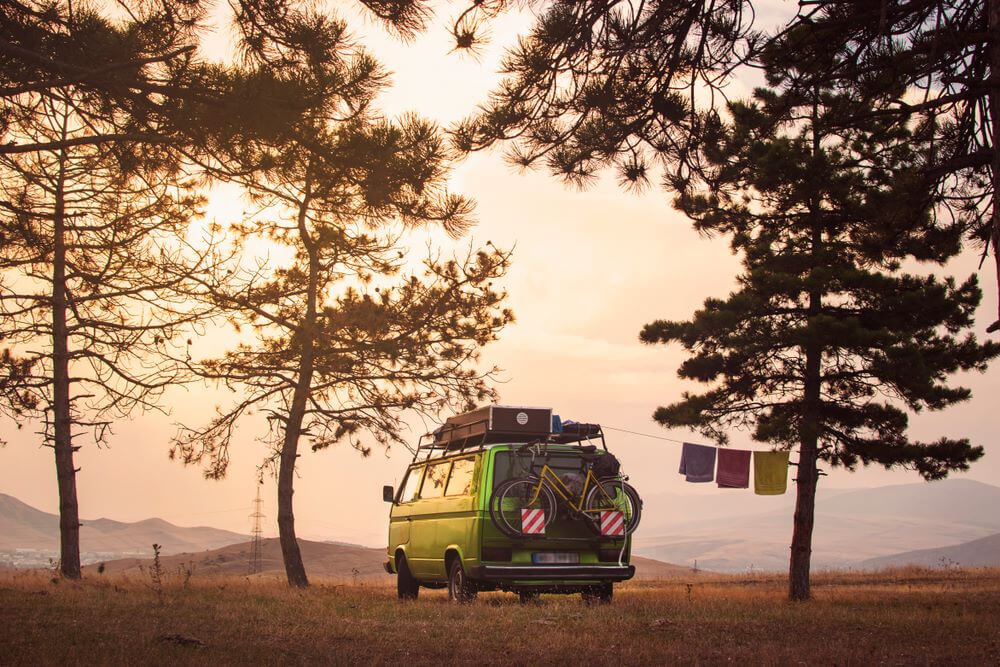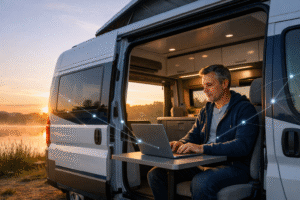Safety Equipment for Van Life: Fire Extinguishers, Carbon Monoxide Detectors, and Alarms

Are you planning a van life adventure? It’s important to prioritize safety when it comes to living on the road. One crucial aspect is equipping your caravan or motorhome with the right safety equipment. In this blog post, I’ll discuss the importance of fire extinguishers, carbon monoxide detectors, and alarms for your van life journey.
When it comes to fire safety, maintaining proper pitch spacing and keeping a distance between your vehicle and other equipment is essential. Additionally, having a suitable fire extinguisher on board, along with fire blankets, can be lifesaving in case of emergencies. It’s also crucial to regularly test your safety equipment and have spare batteries on hand.
Carbon monoxide is another serious risk in caravans and motorhomes. It’s important to have devices that can detect this deadly gas. Carbon monoxide can occur before a visible fire, so being aware of the dangers and taking precautions is crucial. Gas and charcoal BBQs can also pose a carbon monoxide risk if used in confined spaces.
Stay tuned as I delve deeper into the specific safety rules and regulations surrounding fire extinguishers, carbon monoxide detectors, and alarms for van life. Let’s ensure your adventure on the road is not only exciting but also safe!
Key Takeaways
- Fire safety rules for caravans and motorhomes include maintaining proper pitch spacing and keeping a distance between the vehicle and other equipment.
- Carbon monoxide is a serious risk in caravans and motorhomes, and it is important to have devices that can detect it.
- Gas and charcoal BBQs can also pose a carbon monoxide risk if used in confined spaces.
- It is recommended to have separate carbon monoxide and smoke/fire detectors in caravans and motorhomes.
- Fire blankets can be useful for tackling fires and can also be used as a protective body wrap.
Understanding the Dangers: Fire and Carbon Monoxide Risks in Van Life
Common Fire Hazards in Vehicles
When it comes to van life, it’s important to be aware of the potential fire hazards that can arise in vehicles. Maintaining proper pitch spacing and keeping a distance between the vehicle and other equipment are essential fire safety rules for caravans and motorhomes. Additionally, it is crucial to have suitable fire extinguishers on board and regularly check their type and condition. Powder fire extinguishers and fire blankets are recommended for tackling potential fires. Fire blankets can also be used as a protective body wrap in case of emergencies.
The Invisible Threat of Carbon Monoxide
Carbon monoxide (CO) is a serious risk in caravans and motorhomes, and it is imperative to have devices that can detect it. CO can occur before a visible fire, making it a hidden danger. Carbon monoxide detectors and alarms are essential safety equipment for van life. These detectors should be separate from smoke/fire detectors and should be installed in accordance with the 2022 Welsh legislation. Look for CO alarms that are kitemarked to the British Standard (BS EN50291-1 and BS EN50291-2) and have a product lifespan of 10 years. Some CO alarms even have a digital display that shows CO levels and peak level memory.
Risks of Using Gas and Charcoal BBQs in Confined Spaces
Enjoying a BBQ while on the road can be a great experience, but it’s crucial to understand the risks associated with using gas and charcoal BBQs in confined spaces. These BBQs can pose a carbon monoxide risk if used in enclosed areas like caravans. It is important to ensure proper ventilation and never leave a BBQ unattended. Spent charcoal should be properly cooled down before discarding. By following these safety precautions, you can enjoy a tasty BBQ while minimizing the risk of carbon monoxide exposure.
In conclusion, understanding the dangers of fire and carbon monoxide risks in van life is essential for a safe and enjoyable travel experience. By being aware of common fire hazards in vehicles, installing carbon monoxide detectors and alarms, and taking precautions when using gas and charcoal BBQs, you can mitigate the risks and ensure a safer journey. Remember to regularly test your safety equipment, have spare batteries on board, and prioritize personal safety by evacuating the vehicle in case of a fully established fire. Stay safe on the road and enjoy your van life adventures!
Essential Safety Equipment: Fire Extinguishers and Carbon Monoxide Detectors
Ensuring the safety of your van life adventures is of utmost importance. Two essential safety equipment items that every van lifer should have on board are fire extinguishers and carbon monoxide detectors. Let’s delve into the details of choosing the right fire extinguisher and the proper installation and maintenance of both fire extinguishers and carbon monoxide detectors.
Choosing the Right Fire Extinguisher
When it comes to fire extinguishers, it’s crucial to select the right type for your van. Fire extinguishers should be manufactured in accordance with BS (EN)3 and tested and approved by reputable organizations such as the British Standards Institute (BSI), Loss Prevention Council Certificate Board (LPCB), or British Approvals for Fire Equipment (BAFE). They should be colored entirely signal red, with different color-coded areas to determine the contents, such as water, foam, powder, or carbon dioxide.
The selection and installation of fire extinguishers are classified according to the alphabet, where A is for water, B for flammable liquids, C for flammable gases, D for flammable metals, and F for cooking oils and fats. It’s important to choose the appropriate type based on the potential fire hazards in your van.
Proper Installation and Maintenance of Fire Extinguishers
Once you have the right fire extinguisher, proper installation is key. Locate the extinguisher in a dedicated bracket near the door but not too close to cooking appliances. Regularly check the extinguisher according to the manufacturer’s instructions or replace it every 3-5 years. This ensures that it remains in good working condition and ready to tackle any potential fires.
Benefits of Carbon Monoxide Detectors
Carbon monoxide (CO) is a serious risk in confined spaces like caravans and motorhomes. Having carbon monoxide detectors on board is crucial to detect this odorless and invisible gas. CO can occur before a visible fire, making it essential to be aware of the dangers and take precautions.
Certifications and Standards to Look For
When choosing carbon monoxide detectors, look for those that have been designed, tested, and certified as safe for use in caravans, motorhomes, boats, and tents. The CO alarms should be kitemarked to the British Standard (BS EN50291-1 and BS EN50291-2) and have a product lifespan of 10 years. Some CO alarms even have a digital display to show CO levels and peak level memory. Additionally, consider models that are suitable for the 2022 Welsh and Scottish legislation, depending on your location.
In conclusion, having the right safety equipment, such as fire extinguishers and carbon monoxide detectors, is essential for a safe and worry-free van life experience. By choosing the appropriate equipment and ensuring proper installation and maintenance, you can have peace of mind while enjoying your travels. Stay safe on the road!
Additional Safety Measures: Fire Blankets and First Aid Kits
Utilizing Fire Blankets for Fire Prevention and Protection
When it comes to fire safety in van life, it’s essential to have the right equipment on hand. One crucial safety measure is the use of fire blankets. These versatile tools can help prevent and protect against fires.
Fire blankets are made from flame-resistant materials and can be used to smother small fires, especially those caused by cooking accidents or flammable liquids. They are particularly effective for tackling cooking oil and fat fires, as they can quickly extinguish the flames and prevent them from spreading.
In addition to their firefighting capabilities, fire blankets can also serve as a protective body wrap in case of a fire emergency. By wrapping yourself in a fire blanket, you can shield your body from the heat and smoke while you safely evacuate the area.
Importance of Having a Well-Stocked First Aid Kit
Alongside fire blankets, another crucial safety measure for van life is having a well-stocked first aid kit. Accidents and injuries can happen at any time, and being prepared can make all the difference in providing immediate care.
A comprehensive first aid kit should include essential items such as bandages, adhesive tape, antiseptic wipes, gauze pads, tweezers, and scissors. It’s also advisable to have items specific to van life, such as burn dressings and emergency blankets.
When it comes to first aid, it’s important to regularly check and replenish your supplies to ensure they are up to date and in good condition. Additionally, it’s essential to familiarize yourself with basic first aid techniques and know how to use the items in your kit effectively.
By having a well-stocked first aid kit readily available, you can promptly address any injuries or burns that may occur during your van life adventures.
Remember, safety should always be a priority. Regularly test your safety equipment, such as fire blankets and first aid kits, and ensure you have spare batteries on board. By taking these additional safety measures, you can enjoy your van life journey with peace of mind.
Testing and Maintenance: Ensuring Safety Equipment Functionality
Ensuring the functionality of safety equipment is crucial for the safety and well-being of van life enthusiasts. Regular testing and maintenance of safety equipment should be a top priority to minimize risks and ensure optimal performance. Let’s explore some key aspects of testing and maintaining safety equipment for van life.
Regular Testing and Inspection of Safety Equipment
Regular testing and inspection of safety equipment, such as fire extinguishers and carbon monoxide detectors, is essential to ensure their effectiveness in emergency situations. It is recommended to follow the manufacturer’s instructions for testing frequency and procedures. Conducting routine tests can help identify any issues or malfunctions early on, allowing for timely repairs or replacements.
Importance of Carrying Spare Batteries
Having spare batteries on board is crucial for safety equipment that relies on battery power, such as carbon monoxide detectors and alarms. It is advisable to carry extra batteries to ensure uninterrupted functionality. Regularly checking the battery levels and replacing them as needed will help maintain the reliability of these devices.
Recommended Lifespan and Warranty of Safety Equipment
Safety equipment, including fire extinguishers and carbon monoxide detectors, have recommended lifespans set by the manufacturers. It is important to be aware of these recommendations and replace the equipment accordingly. Additionally, checking the warranty of safety equipment is essential to ensure coverage in case of any defects or failures.
To further enhance safety, it is advisable to invest in safety equipment that is certified and meets industry standards. This ensures that the equipment has undergone rigorous testing and complies with regulations. When purchasing safety equipment, always look for reputable brands and check for certifications and standards compliance.
By prioritizing regular testing, carrying spare batteries, and following recommended lifespans and warranties, van life enthusiasts can ensure the functionality and reliability of their safety equipment. This proactive approach will help create a safer and more secure environment during their adventures on the road.
Choosing the Right Safety Equipment: Factors to Consider
Ensuring the safety of your van life adventure is of utmost importance. When it comes to selecting the right safety equipment, there are several factors to consider. Let’s explore different types of fire extinguishers for specific situations, features to look for in carbon monoxide detectors, and criteria for selecting fire blankets.
Different types of fire extinguishers for specific situations
Fire extinguishers are a standard safety equipment for caravans and motorhomes. It is crucial to choose the right type of extinguisher for different fire scenarios. The selection is classified according to the alphabet, such as A for water, B for flammable liquids, C for flammable gases, D for flammable metals, and F for cooking oils and fats. It is important to check the color-coded areas on the extinguisher to determine its contents.
Features to look for in carbon monoxide detectors
Carbon monoxide (CO) is a serious risk in caravans and motorhomes, making it essential to have reliable detectors. Look for CO detectors that have been designed, tested, and certified as safe for use in boats, tents, caravans, and motorhomes. These detectors should be kitemarked to the British Standard (BS EN50291-1 and BS EN50291-2) and have a product lifespan of 10 years. Some detectors even have a digital display to show CO levels and peak level memory.
Criteria for selecting fire blankets
Fire blankets can be a useful tool for tackling fires and can also be used as a protective body wrap. When selecting a fire blanket, ensure that it conforms to BSEN 1869 and has approval by LPC or BAFE. It is important to have fire blankets that are effective for cooking oil/fat fires. Additionally, fire extinguishers should be located in a dedicated bracket near the door but not too close to cooking appliances.
In conclusion, choosing the right safety equipment for your van life adventure requires careful consideration. Selecting the appropriate fire extinguishers, carbon monoxide detectors, and fire blankets can greatly enhance your safety and peace of mind on the road.
Safety Equipment Placement and Regulations
Recommended locations for fire extinguisher placement
When it comes to fire safety in vans, having a suitable fire extinguisher on board is essential. But where should you place it for easy access in case of an emergency? The general recommendation is to locate the fire extinguisher in a dedicated bracket near the door. This ensures that it is easily visible and within reach when needed. However, it’s important to avoid placing it too close to cooking appliances to prevent accidental activation or obstruction.
Flame-retardant materials in van upholstery
New touring caravans are required to use flame-retardant foam in upholstery and match-resistant cushion covers. These safety measures are in place to reduce the risk of fire and slow down the spread of flames in case of an incident. When purchasing a van or considering upholstery replacements, ensure that the materials used meet the necessary safety standards.
Placement of smoke detectors and carbon monoxide alarms
In order to detect potential fires and the presence of carbon monoxide, it is important to have both smoke detectors and carbon monoxide alarms installed in your van. Smoke detectors should be placed in all new and second-hand caravans, while carbon monoxide alarms are essential for safety while camping, boating, or on a caravan trip. Follow the manufacturer’s instructions for proper placement and regularly test these devices to ensure they are in working order.
Regulations for spacing between vehicles and equipment
Maintaining proper spacing between vehicles and equipment is crucial for fire safety in vans. Caravans should be placed with at least six meters between walls and three meters clear between associated equipment and adjacent caravans. This helps to reduce the risk of fire spreading between vehicles and provides sufficient space for emergency access and evacuation if needed. Additionally, fire risk assessments are available on caravan sites and should be followed to ensure compliance with safety regulations.
Conclusion and Final Thoughts
Prioritizing personal safety in case of emergencies
When it comes to van life and traveling on the road, prioritizing personal safety is of utmost importance. Emergencies can happen at any time, and being prepared can make all the difference. It is crucial to have the necessary safety equipment on board to handle potential hazards effectively. Fire extinguishers, carbon monoxide detectors, and alarms are essential tools to ensure a safe and secure living environment in your van or motorhome.
Adhering to fire risk assessments and regulations
To maintain a high level of safety, it is important to adhere to fire risk assessments and regulations specific to caravans and motorhomes. This includes maintaining proper pitch spacing, keeping a distance between the vehicle and other equipment, and following guidelines for the installation and use of fire safety equipment. By following these regulations, you can minimize the risk of fire and ensure the safety of yourself and others.
Safe usage and disposal of barbecues on caravan sites
Barbecues can be a great way to enjoy outdoor cooking while on a caravan trip. However, it is important to use and dispose of barbecues safely to prevent accidents and minimize the risk of carbon monoxide poisoning. Gas and charcoal BBQs can pose a carbon monoxide risk if used in confined spaces, so it is essential to ensure proper ventilation. Additionally, barbecues should not be left unattended, and spent charcoal should be properly cooled down before discarding.
In conclusion, safety should always be the top priority when it comes to van life and traveling in a caravan or motorhome. By having the necessary safety equipment, adhering to fire risk assessments and regulations, and practicing safe usage and disposal of barbecues, you can create a safe and secure living environment while on the road. Remember to regularly test and maintain your safety equipment, and always be prepared for emergencies. Stay safe and enjoy your van life adventures!
Frequently Asked Questions
1. What are the fire safety rules for caravans and motorhomes?
Fire safety rules for caravans and motorhomes include maintaining proper pitch spacing and keeping a distance between the vehicle and other equipment.
2. Why is carbon monoxide a serious risk in caravans and motorhomes?
Carbon monoxide is a serious risk in caravans and motorhomes because it can occur before a visible fire, and it is important to be aware of the dangers and take precautions.
3. Can gas and charcoal BBQs pose a carbon monoxide risk in caravans and motorhomes?
Yes, gas and charcoal BBQs can also pose a carbon monoxide risk if used in confined spaces.
4. What type of detectors should be installed in caravans and motorhomes?
It is recommended to have separate carbon monoxide and smoke/fire detectors in caravans and motorhomes.
5. What are the better alternatives to ionization-type smoke detectors in small living spaces?
Optical smoke detectors and heat detectors are better alternatives to ionization-type smoke detectors in small living spaces
6. What safety equipment should be on board caravans and motorhomes?
It is important to have a suitable fire extinguisher, fire blankets, ConnectPls internet and first aid kits on board caravans and motorhomes.
7. How often should safety equipment be tested?
Safety equipment should be regularly tested according to the manufacturer’s instructions, and spare batteries should be available on board.
8. What type of fire extinguishers and fire blankets are recommended?
Powder fire extinguishers and fire blankets are recommended for tackling potential fires in caravans and motorhomes.
9. How should fire extinguishers be located in caravans and motorhomes?
Fire extinguishers should be located in a dedicated bracket near the door but not too close to cooking appliances.



